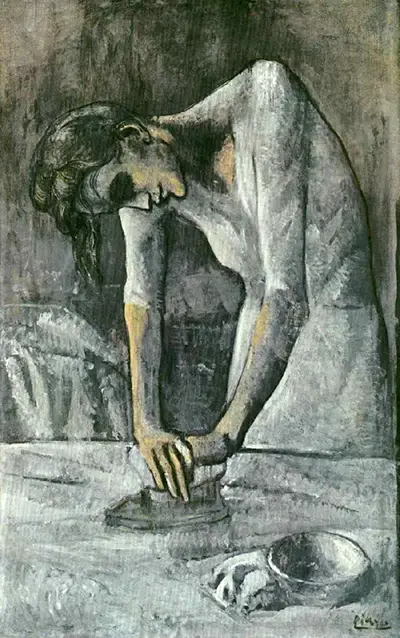During this period Picasso was still a struggling artist and living in relative poverty. The suicide of his friend and fellow artist, Carlos Casagemas in 1901 affected him deeply. This event appeared to trigger an inner turmoil in Picasso which eventually found an outlet through his work.
Picasso's paintings during this period were sad and melancholy. Often the subject matter featured scenes of hardship or misery. The paintings during this period are also distinctive because of the monochromatic tones of blue that he used. Some examples from this period include La Vie, The Old Guitarist and The Blue room.
Woman Ironing is a particularly sensitive and expressive piece which evokes sympathy for the working poor. Images of labour were common during the late 19th and early 20th century. Degas in particular used this theme frequently and often featured hard-working ballerinas and milliners. It was also Degas' 1890 image of a Woman Ironing that Picasso mirrored.
Picasso's Woman Ironing features an emaciated woman with hollow eyes and sunken cheeks, pressing down on her iron. Hair falls down across her face and she appears weary through hours of hard labour. Picasso has deliberately used an elongated and angular style which may have been inspired by the artist El Greco's use of elongation in his pieces.
In doing this, Picasso achieves a sensitive almost sensual portrait of the woman at her labour. The piece speaks volumes of the "misfortunes of the poor" and what Picasso was likely to be experiencing at the time too - often painting at night by oil lamp.
The colours, woman's features and Picasso's clever use of white and greys convey a feeling of space in the painting. This adds to the sense of loneliness and suffering that the viewer can almost feel when they look at the woman ironing. The model for this picture has been named as "Margot". Margot was the daughter of a café owner, the proprietor of Le Lapin Agile Café where Picasso and his friends often gathered. Margot appears in some other canvases by Picasso after 1904.
Picasso knew what poverty felt like and often had to re-use his own canvasses in order to continue painting. In 1989, when a study of the painting Woman Ironing was being carried out, an exciting discovery was made. The study revealed that there was another picture upside down on the canvas underneath the paint.
More recent technology using X-ray has successfully provided further details about the image that lies underneath Woman Ironing. The original image Picasso painted on the canvas was a portrait of a man with a bright red neck-tie - clearly painted before Picasso fell into his Blue Period.
While the painting underneath the Woman Ironing was being studied, the Woman Ironing was cleaned and stabilized, bringing out even more of Picasso's wonderful skills and subtle colour differences in this limited palette of colours. Woman Ironing is held by the Solomon R. Guggenheim Museum in New York and perhaps shows how a young Picasso was beginning to really develop his techniques - creating much lighter, elegant and fluid figures - as he slowly emerged from his "Blue Period".
Woman Ironing is a mesmerizing painting that captures everyday life, the toil and hard labour that the poor were experiencing at that time. Picasso's skills as an artist ensure that the viewer cannot help but feel sympathy for this poor woman at work.

